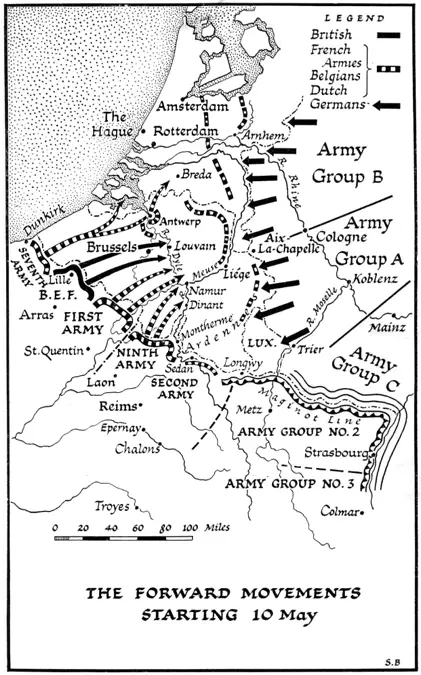Holland and Belgium, assaulted without the slightest pretext of warning, cried aloud for help. The Dutch had trusted to their water-line; all the sluices not seized or betrayed were opened, and the Dutch frontier guards fired upon the invaders. The Belgians succeeded in destroying the bridges of the Meuse, but the Germans captured intact two across the Albert Canal.
By Plan D, the First Allied Army Group, under General Billotte, with its small but very fine British army, was, from the moment when the Germans violated the frontier, to advance east into Belgium. It was intended to forestall the enemy and stand on the line Meuse-Louvain-Antwerp. In front of that line, along the Meuse and the Albert Canal, lay the main Belgian forces. Should these stem the first German onrush, the Army Group would support them. It seemed more probable that the Belgians would be at once thrown back onto the Allied line. And this, in fact, happened. It was assumed that in this case the Belgian resistance would give a short breathing-space, during which the French and British could organise their new position. Except on the critical front of the French Ninth Army, this was accomplished. On the extreme left or seaward flank the Seventh French Army was to seize the islands commanding the mouth of the Scheldt, and, if possible, to assist the Dutch by an advance toward Breda. It was thought that on our southern flank the Ardennes were impassable for large modern armies, and south of that again began the regular fortified Maginot Line, stretching out to the Rhine and along the Rhine to Switzerland. All therefore seemed to depend upon the forward left-handed counterstroke of the Allied Northern Armies. This again hung upon the speed with which Belgium could be occupied. Everything had been worked out in this way with the utmost detail, and only a signal was necessary to hurl forward the Allied force of well over a million men. At 5.30 A.M. on May 10, Lord Gort received a message from General Georges ordering “Alertes 1, 2, and 3”; namely, instant readiness to move into Belgium. At 6.45 A.M. General Gamelin ordered the execution of Plan D, and the long-prepared scheme of the French High Command, to which the British had subordinated themselves, came at once into action.

* * * * *
Mr. Colijn, when as Dutch Prime Minister he visited me in 1937, had explained to me the marvellous efficiency of the Dutch inundations. He could, he explained, by a telephone message from the luncheon table at Chartwell, press a button which would confront an invader with impassable water obstacles. But all this was nonsense. The power of a great State against a small one under modern conditions is overwhelming. The Germans broke through at every point, bridging the canals or seizing the locks and water-controls. In a single day all the outer line of the Dutch defences was mastered. At the same time the German Air Force began to use its might upon a defenceless country. The Dutch hope that they would be bypassed by the German right-handed swing as in the former war was vain.
The case of Belgium requires more searching statement. Several hundreds of thousands of British and French graves in Belgium mark the struggle of the previous war. The policy of Belgium in the years between the wars had not taken sufficient account of the past. The Belgian leaders saw with worried eyes the internal weakness of France and the vacillating pacifism of Britain.
1 comment